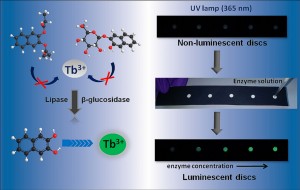PAPER DISCS FOR DETECTING ENZYMES
Biosensors are devices used to detect biological elements like tissues, microorganisms, enzymes, etc. by measuring the interaction of a chemical substance with the biological element. The interaction is quantified byconverting it into an electrical or a light signal. They have become important in many fields, including in disease diagnosis, especially in the developing and under-developed parts of the world.

ImageJ=1.46r
unit=inch
In recent years, biosensors made with paper substrates have generated much interest because they are easily available, are inexpensive and biodegradable. The porous nature of paper also allows the target chemical to diffuse easily.
Uday Maitra’s lab specializes in developing such paper biosensors. Recently Maitra and his student, TumpaGorai, fabricated a low-cost paper biosensor that rapidly detects the presence of lipase, a pancreatic enzyme that breaks down fats into smaller molecules called fatty acids and glycerol during the process of digestion.* While a certain amount of lipase is important for maintaining normal digestive function, an abnormally high level of lipase indicates damage to the pancreas.
Recently Maitra and his student, TumpaGorai, fabricated a low-cost paper biosensor that rapidly detects the presence of lipase, a pancreatic enzyme that breaks down fats into smaller molecules called fatty acids and glycerol during the process of digestion
The biosensor comprises a paper disc, embedded within which is a gel, made with terbium—a rare earth metal—and doped with a synthetic enzyme substrate. As the disc comes in contact with lipase, it turns green when illuminated under UV light. The change in intensity of the colour indicates the amount of the enzyme present in the sample. What’s more, it costs merely one rupee to make five such paper discs.
Maitra’s lab has developed many such gels that make use of rare earth metals which emit light upon photoexcitation. “We have engineered these gels to have tuneable colours. One of them we developed helps in the detection of enzymes,” says Maitra.
* TumpaGorai and UdayMaitra. 2016. Supramolecular approach to enzyme sensing on paper discs using lanthanide photoluminescence. ACS Sensors. 1(7):934–940




